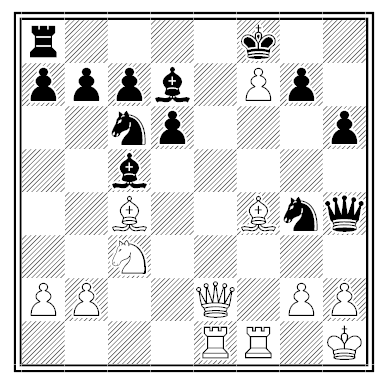Dylan Thomas’ 1954 play Under Milk Wood is set in the town of Llareggub.
Is that a real Welsh village? Or is it a stand-in for Laugharne, where Thomas lived in the 1930s?
Neither — read it backward.
Dylan Thomas’ 1954 play Under Milk Wood is set in the town of Llareggub.
Is that a real Welsh village? Or is it a stand-in for Laugharne, where Thomas lived in the 1930s?
Neither — read it backward.
G.K. Chesterton used the term moor eeffocish to describe the queerness sometimes glimpsed in familiar things. He borrowed the phrase from Charles Dickens, who as an unhappy child would sometimes sit in a coffee shop in St. Martin’s Lane:
In the door there was an oval glass plate with ‘COFFEE ROOM’ painted on it, addressed towards the street. If I ever find myself in a very different kind of coffee-room now, but where there is such an inscription on glass, and read it backwards on the wrong side, MOOR EEFFOC (as I often used to do then in a dismal reverie), a shock goes through my blood.
J.R.R. Tolkien later wrote: “The word Mooreeffoc may cause you to realise that England is an utterly alien land, lost either in some remote past age glimpsed by history, or in some strange dim future reached only by a time-machine; to see the amazing oddity and interest of its inhabitants and their customs and feeding-habits.”
Benjamin Disraeli often received unsolicited manuscripts from authors seeking his opinion. He had a standard reply:
“Thank you for the manuscript; I shall lose no time in reading it.”
See also Backhanded Letters of Reference.
Singular circumstance — A lady resident in Devonshire, going into one of her parlours, discovered a young ass, who had found its way into the room, and carefully closed the door upon himself. He had evidently not been long in this situation before he had nibbled a part of Cicero’s Orations, and eaten nearly all the index of a folio edition of Seneca in Latin, a large part of a volume of La Bruyere’s maxims in French, and several pages of Cecilia. He had done no other mischief whatever, and not a vestige remained of the leaves that he had devoured. Will it be fair henceforward to dignify a dunce with the name of this literary animal?
— Pierce Egan, Sporting Anecdotes, Original and Selected, 1822
Tennyson’s poem “The Vision of Sin” contains this couplet:
Every moment dies a man,
Every moment one is born.
When he published it in 1842, Charles Babbage sent him a note:
I need hardly point out to you that this calculation would tend to keep the sum total of the world’s population in a state of perpetual equipoise, whereas it is a well-known fact that the said sum total is constantly on the increase. I would therefore take the liberty of suggesting that, in the next edition of your excellent poem, the erroneous calculation to which I refer should be corrected as follows:–
Every moment dies a man,
And one and a sixteenth is born.
“I may add that the exact figures are 1.167,” he added, “but something must, of course, be conceded to the laws of metre.”
WILLIAM SHAKESPEARE is an anagram of I AM A WEAKISH SPELLER.

“People from a planet without flowers would think we must be mad with joy the whole time to have such things about us.” — Iris Murdoch

Jules Verne earned his title as the father of science fiction: His 1865 novel From the Earth to the Moon contains eerie similarities to the Apollo program that unfolded a century later.
Like Apollo 11, Verne’s story involved a crew of three being launched from the United States on a trip around the moon. The two spacecraft were of similar dimensions and weight, and both were mostly aluminum. (Verne’s craft was shot from a cannon called the Columbiad; Apollo 11’s command module was called Columbia.) Both were launched from the Florida peninsula after a competition with Texas; Congress resolved a similar contest in the 1960s, choosing Houston as home of Mission Control and Florida as the launch site — indeed, Verne’s craft takes off only 136 miles from today’s Kennedy Space Center. Both crews experienced weightlessness and used retrorockets, both missions were monitored by ground crews using telescopes, and both craft splashed down in the Pacific and were recovered by the Navy.
Some of this was guesswork, but some involved careful thought and intelligent speculation. Verne recognized that a vehicle can be launched into space most easily from low latitudes, and he undertook his own engineering analysis to design the projectile and the cannon that fired it. In his other novels, Verne describes antecedents of helicopters, air conditioning, projectors, automobiles, jukeboxes, the Internet, television, and submarines. “What one man can imagine,” he wrote, “another can do.”
Rudolf Charousek had been playing chess for only four years when he found himself facing this position against Jakob Wollner at Kaschau in 1893:

He found one of the most immortally pretty finishes in chess history — to discover it, read Kester Svendsen’s 1947 short story “Last Round,” which the game inspired.
Three years afterward, Charousek defeated Lasker at Nuremberg. “I shall have to play a championship match with this man someday,” the master remarked, but it was not to be — the Hungarian died of tuberculosis in 1900, at only 26.

Each book in Dante’s Divine Comedy ends with the word stars.